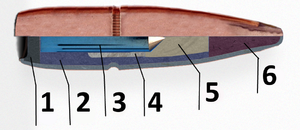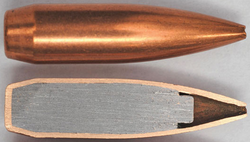m (→Design) |
(→Design) |
||
| Line 14: | Line 14: | ||
For amenities, the Mark 15 features an ambidextrous fire selector, magazine release, and bolt catch, ammunition counter, 6-position skeletonized buttstock, and a fully-customizable handguard with 4 modular rail units. The design is fully modular, and can accept a variety of sights, stocks, grips, and other accessories, as well as longer or shorter barrels. . | For amenities, the Mark 15 features an ambidextrous fire selector, magazine release, and bolt catch, ammunition counter, 6-position skeletonized buttstock, and a fully-customizable handguard with 4 modular rail units. The design is fully modular, and can accept a variety of sights, stocks, grips, and other accessories, as well as longer or shorter barrels. . | ||
The Mark 15 is entirely made from special stamped temperature-resistant alloys, with most parts made from high-grade polymers and alloys for durability and longevity. The result of this is a rather lightweight platform, at roughly 3 kilograms fully loaded with a 50-round magazine, but also one that is intensely durable and can withstand all types of environments and pressures. | The Mark 15 is entirely made from special stamped temperature-resistant alloys, with most parts made from high-grade polymers and alloys for durability and longevity. The result of this is a rather lightweight platform, at roughly 3 kilograms fully loaded with a 50-round magazine, but also one that is intensely durable and can withstand all types of environments and pressures.. | ||
The second generation of Mark 15 rifles, dubbed '''Mark 15 Gen. 2''', abandons the 50-round stick magazines in favor of a more traditional quad-stacked, conveyor-operated 50-round box magazine. The battery has been relocated above and behind the bolt, as the entire system has been simplified and lightened further. | The second generation of Mark 15 rifles, dubbed '''Mark 15 Gen. 2''', abandons the 50-round stick magazines in favor of a more traditional quad-stacked, conveyor-operated 50-round box magazine. The battery has been relocated above and behind the bolt, as the entire system has been simplified and lightened further. | ||
Revision as of 07:09, 9 April 2018

The Mark 15 Adaptive Rifle System is a compact, magazine-fed, open bolt, electronic impulse, electromagnet-assisted delayed blowback-operated automatic rifle employing a high-velocity 6mm caseless round. It is a further development of the Mark 30 Personal Defense Weapon, and shares many design aspects with it's predecessor.
History
The Mark 15 is a development of the aging Mark 30 PDW chambered in a new 6x28mm high-velocity caseless round developed from the older 7.62x33mm caseless round. Featuring better penetration and similar range at a smaller size and weight, the round was quickly adopted as a replacement in Solas Tempus service and serves as a ballistic fallback option for new arrivals, special operations personnel, or for targets requiring alternate methods of disposal. Unlike the PDW however, the Mark 15 was designed from the ground up to be an offensive weapon, created with the needs of TACCOM, TEMPCOM, and SPECCOM in mind.
Following the cancellation of the Mark 24 SABER program, efforts to create a mid-to-long range rifle for more practical applications included creating a longer Mark 15 "DMR" variant, featuring a 24-inch barrel (or 16-inch barrel with suppressor). This variant is currently undergoing final-stage testing and will be issued to appropriate personnel in mid-2384.
Design
Like the Mark 30 PDW, the Mark 15 operates on an electronic impulse, delayed-blowback closed-or-open bolt action, feeding from specialized 50-round stick magazines that store rounds perpendicular to the bore axis similar in design to the P90's stick magazine. Essentially, the feed lips of the magazine are attached to a gate that rotates 90 degrees, placing the next round along the bore axis and allowing the bolt to carry the round into battery. In open bolt mode, the advanced primer ignition system uses an electronic impulse to fire the primer very briefly before the bolt actually goes into battery, which normally requires precise timing based on different ammunition types to maximize efficiency. However, a rechargeable lithium-ion battery located inside the "magazine well" powers an electromagnet as well as the firing pin, which compensates for different recoil forces and ensures perfect operation of the mechanism. To use the more accurate closed bolt system, the operator must insert the magazine and hit the bolt release paddle, which will push the round into battery but not fire it. It will then operate normally. Due to the nature of the system, the rate of fire can be tuned via a recessed dial underneath the battery, from 300 RPM up to 1,100 RPM.
The system itself reduces recoil forces compared to a regular straight blowback system, and special compensators and buffers in the stock serve to reduce the recoil even further to manageable levels. Surprisingly, the weapon only has two fire modes: safe, and full-auto. There is no semi-automatic function, although this is compensated by the tuneable rate of fire and the fact that the weapon is not capable of bump-firing or other accidental discharges common to open bolt designs due to the requirement of a full electronic impulse input from the battery and firing mechanism.
For amenities, the Mark 15 features an ambidextrous fire selector, magazine release, and bolt catch, ammunition counter, 6-position skeletonized buttstock, and a fully-customizable handguard with 4 modular rail units. The design is fully modular, and can accept a variety of sights, stocks, grips, and other accessories, as well as longer or shorter barrels. .
The Mark 15 is entirely made from special stamped temperature-resistant alloys, with most parts made from high-grade polymers and alloys for durability and longevity. The result of this is a rather lightweight platform, at roughly 3 kilograms fully loaded with a 50-round magazine, but also one that is intensely durable and can withstand all types of environments and pressures..
The second generation of Mark 15 rifles, dubbed Mark 15 Gen. 2, abandons the 50-round stick magazines in favor of a more traditional quad-stacked, conveyor-operated 50-round box magazine. The battery has been relocated above and behind the bolt, as the entire system has been simplified and lightened further.
Ammunition

There are several main types of ammunition designed specifically for the Mark 15, not including TR-240 rounds that are compatible with the Mark 15 platform.
Mark 35 Mod. 0 HE-I/AP
The standard 137-grain boattail 6mm Mark 35 Mod. 0 High-Explosive, Incendiary, Armor-Piercing round is composed of incendiary mix, zirconium powder, HE mix, and a depleted uranium penetrator inside a steel cup, all encased in a copper jacket. It is designed to defeat most common forms of body armor and explode inside the target, with a pyrotechnical detonation train instead of a manual fuse that sets off the HE filler and incendiary mix, to ensure maximum effect and terminal ballistic consistency. Fired from a 10.3-inch unsuppressed barrel, the Mk 35 round generates muzzle velocities of over 800 m/s, with an effective range of 900 meters. AP-I/HE rounds are marked with green tips.
The initial impact of the round ignites the incendiary material in the tip, triggering the detonation of the HE charge. The second (zirconium powder) incendiary charge will also ignite. This burns at a very high temperature, is not easily extinguished, and can last up to 15 minutes. The remaining element of the round is the depleted uranium penetrator. This has a large amount of kinetic energy and will penetrate the armor as solid-cored armor-piercing shot would. This will take the incendiary material and about 20 steel fragments (created by the explosives), delivering them in a 25–30 degree cone through the armor, increasing lethality. Penetration values for HE-I/AP are quantified as ~65mm RHA at 45-degree angle from 100m, out to ~21mm RHA at 45-degree angle at 1000m..
Mark 35 Mod. 2 HE-I/AP-C
A special-purpose variation of the Mark 35 round strictly limited to situational use by Vidant Obscura agents and Temporal Operatives. The mild steel cup of the regular Mark 35 is laced with potent Chroniton particles, which, while not harmful to most humanoids, can do serious damage to those beings that exist out of the timeline. Their nature as Temporal Weapons requires strict oversight of operation and storage. These rounds are designated as Mark 35 Mod. 2 High-Explosive, Incendiary, Armor-Piercing, Chroniton and arae marked with a bright yellow T or V, depending on the department responsible for handling them.

Mark 36 Mod. 0 HVAP-S
A 4.6mm sub-caliber penetrator encased in a cup sabot, designated as the Mark 36 Mod. 0 High-Velocity Armor-Piercing, Sabot round. As the projectile is smaller in diameter and lighter than a conventional round, it is propelled at a higher velocity of roughly 950 m/s when fired out of a 10.3-inch barrel, and the reduced cross section of the penetrator makes it more effective against hard armor. Terminal effects are lessened, although this round is more intended for use against more armored targets such as thin-skinned vehicles or exosuits instead of a standard dismounted infantry unit. HVAP-S rounds are marked with black tips, and weapons firing HVAP-S rounds must have their barrels outfitted with a stellite liner to avoid damaging the rifling with the plastic cup sabot. HVAP penetration is quantified as ~100mm RHA at 45-degree angle from 100m, ~64mm RHA at 45-degree angle from 500m, and ~37mm RHA at 45-degree angle from 1000m.
Mark 36 Mod. 1 HVAP-S-T
A specially-designed sabot round with a tracer tail for in-flight monitoring and better impact gauging, designated as the Mark 36 Mod. 1 High-Velocity Armor-Piercing, Saboted, Tracer. Marked with a short white tip over the black tip.

Mark 37 Long-Range Open-Tipped Match
Designed for long-range performance, the Mark 37 round is a boat-tailed open-tipped cartridge with significantly longer range than Mark 35 or Mark 36 rounds, intended for use in the longer "DMR" barrels of Generation 2 Mark 15 rifles.
Phaser Conversion Kit
The Mark 15 is shipped with a specialized complete upper receiver assembly which allows insertion of a Type 1 "Remote-Type" Hand Phaser into the chamber, much like the Type 2 Assault Phaser. This gives it access to a higher degree of power than the Type 3 phaser rifle, in a sturdier and more modular package. The powerpack is inserted on the handguard's top rail cutout, much like the PDW, while the magazine well can be empty or include an optional battery to power the temperature and ammunition sensors. The ammo counter will track power percentage from 99% instead of number of rounds remaining. Like Mark 30 PDWs, Mark 15s in this configuration are officially designated as Type 2 Phaser Carbines, but are more typically referred to as Phaser PDWs or just PDWs.